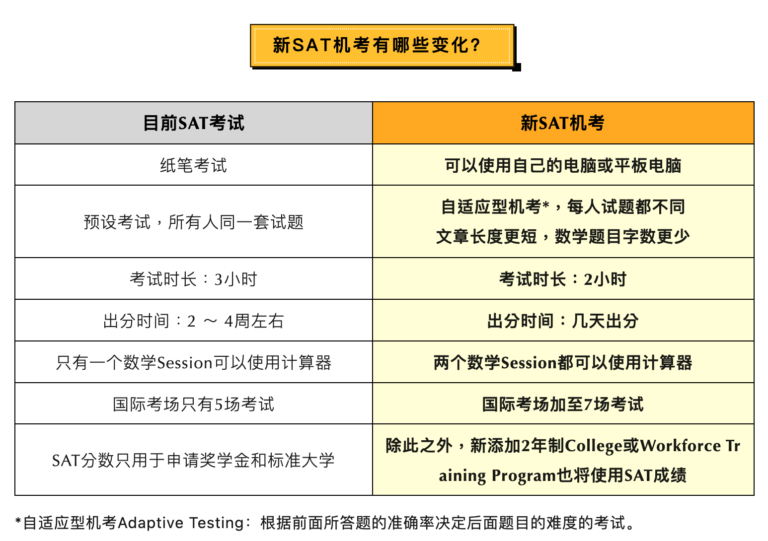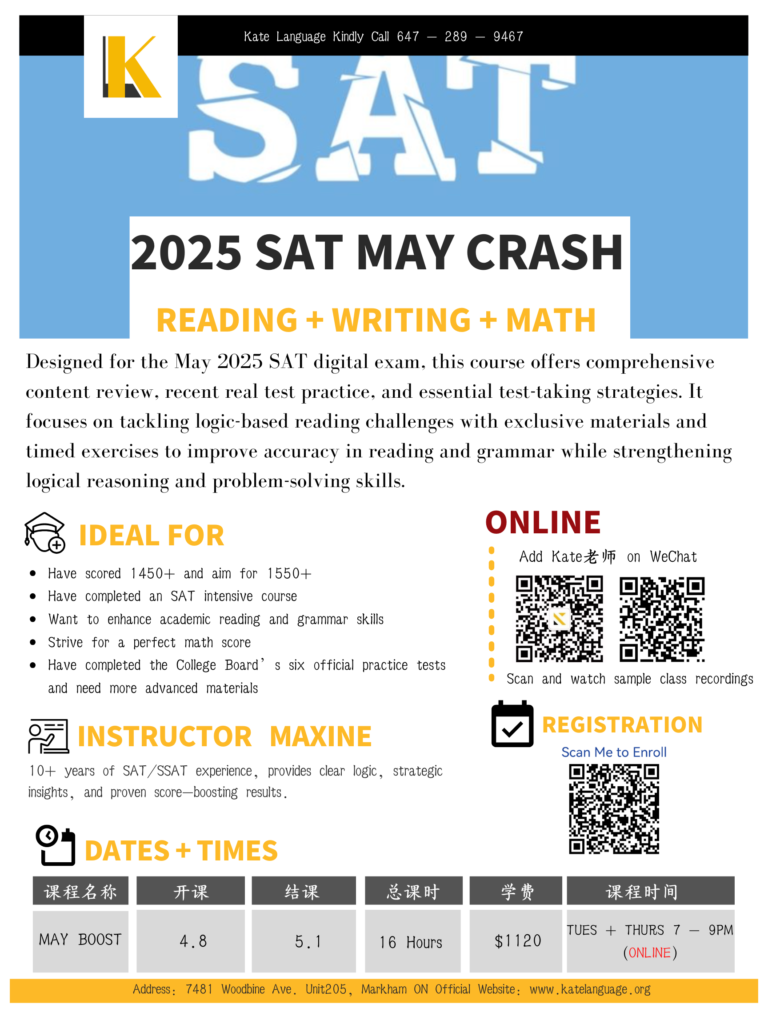SAT Prep
SAT Prep at Kate Language
Kate Language offers comprehensive SAT preparation courses in Toronto, designed to boost scores by 200–400 points. Our SAT prep curriculum combines language skills development with test-taking strategies, utilizing a wealth of practice materials and official resources.
What is the SAT Exam?
The SAT (Scholastic Assessment Test) is an academic ability assessment exam administered by the College Board. Similar to the ACT (American College Test), it is often referred to as the “American college entrance exam.” SAT scores are a crucial part of the application process for undergraduate admission to U.S. universities, as well as for scholarships. The specific requirements may vary by school. Many prestigious U.S. universities believe that the SAT is an effective tool for selecting high-quality students and predicting their academic success and GPA in college.
Explore our high-score showcases and discover how we help students achieve their academic dreams.
What Does the SAT Test?
The SAT is divided into two main sections: Reading and Writing and Math, each worth 800 points. The number of questions is fewer than the paper-based test, and the time is reduced to 2 hours and 14 minutes.
Reading and Writing (64 minutes total):
Module 1 (32 minutes): 25 scored questions + 2 unscored questions
Module 2 (32 minutes): 25 scored questions + 2 unscored questions
Math (70 minutes total):
Module 1 (35 minutes): 20 scored questions + 2 unscored questions
Module 2 (35 minutes): 20 scored questions + 2 unscored questions
There is a 10-minute break between the two modules.

8 Key Skill Areas You Should Focus On for SAT Prep
Standard English Conventions
A lower score indicates weaker grammar skills, such as issues with tense, sentence structure, subject-verb agreement, punctuation, and logical connectors.
Expression of Ideas
Questions focus on the main idea, paragraph meaning, attitude, logical relationships, comparison, and note organization.Information and Ideas
Assesses your understanding and application of information, including data interpretation and detailed analysis.Craft and Structure
Tests vocabulary, including academic words, logical context clues, rhetorical devices, emotional tone, and synonyms.Algebra
Key topics include linear equations, systems of linear equations, inequalities, linear functions, and function graphs.Problem Solving & Data Analysis
Tests skills in ratios, percentages, proportional reasoning, unit conversions, graph interpretation, data analysis, and some statistics.Geometry & Trigonometry
Covers plane geometry, complex numbers, trigonometric functions, polynomial functions, and rational functions.Advanced Math
Focuses on quadratic equations and quadratic functions.
Why Choose Our SAT Prep Program?
SAT Foundation
Planning to take the SAT exam
Looking to improve academic skills
Aiming to improve report card grades
Focuses on SAT computer-based question types. Covers writing, reading structure, and methods for literature, poetry, science, and social science texts. Enhances reading complex sentences and expression skills, with grammar instruction applied in reading and writing. Interactive, practice-based classes.
Includes textbook + 1 midterm mock exam + 1 final mock exam.
SAT Advanced
Taking the SAT exam within 6 months
Aiming for a high score,
Looking to improve academic skills and report card grades.
Designed for the SAT computer-based test, using official practice tests and internal materials. Covers exam question types, patterns, strategies, and traps in a lecture format. Aims to boost SAT preparation and logical academic skills, with techniques applicable to school performance.
Includes 6 mock exams + 1 internal practice textbook.
Private Course
Ideal for students who cannot match class schedules
Aiming to boost their score from near 1500 to 1550+.
Starting with the student’s weaknesses, we customize teaching content, methods, practice, and assignments.
Helping students achieve top scores!
SAT Prep FAQs
The preparation timeline varies for each student, generally falling into two styles: Some students prefer to join the SAT foundation class in 8th or 9th grade to learn about the test and improve their scores without rushing to take the exam, planning to sit for it in 10th or 11th grade. Other students prefer to take the exam immediately after completing both the foundation and intensive classes. Which approach is better? Ms. Kate offers the following suggestions:
To take the SAT or intensive class, students should have completed at least 11th-grade math (this may require students to reach ahead in school or learn it outside of school).
For capable students, it’s best to achieve a score of at least 1450+ by December of 10th grade or at the latest by 11th grade, as this score can be used to apply for credit-bearing summer programs at top U.S. universities.
This is a common question parents often ask, and many believe that taking the SAT more than 2-3 times will negatively affect college applications.
In reality, we recommend taking the SAT 2-3 times. The first attempt can be challenging due to lack of experience and nervousness, which is understandable. However, there’s no need to take the SAT too many times, as scores do not necessarily increase with repeated attempts.
Taking the test multiple times will not impact college applications negatively, as students can use “Score Choice”. This allows them to select and submit only their best test scores to colleges.
For more details, refer to this official College Board video: https://www.youtube.com/watch?v=OgMUw5XUJl0&ab_channel=TheCollegeBoard
01. Number and Operations:
- properties of integers
- arithmetic word problems
- number lines
- squares and square roots
- fractions and rational numbers
- factors, multiples, and remainders
- prime numbers
- ratios, proportions, and percents
- sequences
- sets
- counting problems
- logical reasoning
02. Algebra and Functions
- operations on algebraic expressions
- factoring
- exponents
- evaluating expressions with exponents and roots
- solving equations
- absolute value
- direct traslation into mathematical expressions
- inequalities
- systems of linear equations and inequalities
- rational equations and inequalities
- direct and inverse variation
- word problems
- functions
03. Geometry and Measurement
- geometric notation
- points and lines
- angles in the plane
triangles - quadrilaterals
- areas and perimeters
- other polygons
- circles
- solid geometry
- geometric perception
- coordinate geometry
- transformations
04. Data Analysis, Statistics, and Probability
- data interpretation
- statistics
- elementary probability
- geometric probability
People often assume that SAT scores are valid for only two years. However, neither the College Board nor U.S. universities have explicitly stated that scores are only valid within two years. In general, when students register for an account with the College Board and take the exam, their scores are stored in the system for 5 years, and can be accessed and sent to colleges within that period.
According to the College Board’s standard practice, SAT scores are typically available around 20 days after the exam. Students can log in to the College Board website to check their scores.
No, when submitting application materials, the system allows applicants to choose which SAT score to submit. Only the highest SAT score needs to be submitted, and admissions officers will not see any other unsubmitted scores.


